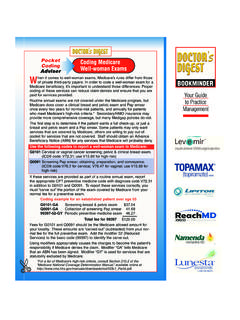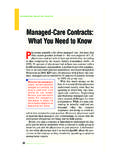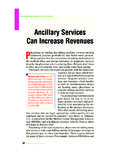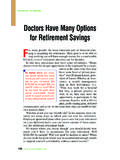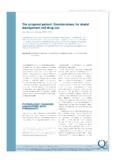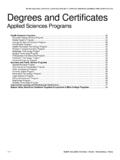Transcription of Squeezing Out Savings In Overhead Costs - …
1 DocDig 3/15/05 3:48 PM Page 104. MAXIMIZING PRACTICE PROFITS. Squeezing Out Savings In Overhead Costs I. n today's tough practicing environment, most physicians are finding it a lot harder to control office expenses. As Overhead continues to eat into revenue, doctors are looking for ways to trim unnecessary spending and keep necessary spending in check. Typically medical practice Overhead ranges from 45 percent to 60 percent of revenue, with some variation for specialty, size of practice, setting and market fac- Larger practices can afford tors.
2 In addition, some practices to employ an educated, are better able to handle expenses board-certified administra- because of their size. tor, says Nancy Babbitt, A Medical Group Management MGMA member and practice Association (MGMA) 2004 report administrator for the Roswell based on 2003 data found that Pediatric Center in Alpharetta, large pediatric groups have lower Ga. This may help those cost ratios than groups with fewer groups negotiate better rates, than four doctors. benchmark the practice against its peers, run the prac- Larger pediatric groups often tice more efficiently and cap- have the ability to negotiate high- ture more revenue.
3 Er rates and realize staffing and other efficiencies because of their size, said Nancy Babbitt, MGMA. member and practice administrator for the Roswell Pediatric Center in Alpharetta, Ga. Larger practices can also afford to em- ploy an educated, board-certified administrator. This may help those groups negotiate better rates, benchmark the practice against its peers, run the practice more efficiently and capture more revenue.. The MGMA survey found that for all practices surveyed, ex- penses increased at a faster pace than revenue over the last five years.
4 Pediatric groups saw an average revenue boost of per- 104 w w w. d o c t o r s d i g e s t . n e t DocDig 3/15/05 3:48 PM Page 105. MAXIMIZING PRACTICE PROFITS. cent over the past five years, but Costs increased percent over the same time period. Keep in mind that pediatric practices gen- erally have high operating Costs due to factors such as vaccine cost and storage and bigger space requirements for examination rooms. What Are the Secrets to Practice Success? The Medical Group Management Association (MGMA) reports that the performance gap between successful medical groups and others is narrowing, and that medical group practices may be taking their cues from successful peers and instituting their management behaviors, thus improving their operations.
5 MGMA's recent report, Performance and Practices of Successful Medical Groups: 2004 Report Based on 2003 Data, shares anecdotes and data about how better performers achieved their success. Whether they are doing more frequent and in-depth patient satisfac- tion surveys or creating new sources of revenue, better-performing practices' entrepreneurial spirit clearly contributes to their success, . said Daniel P. Stech, CMPE, director, MGMA Survey Operations. Multi-specialty, better-performing practices logged a in- crease in total medical revenue after operating cost per full-time-equiv- alent (FTE) physician to $298,255 in 2003 from $280,717 in 2002.
6 All respondents reported a smaller increase at percent with $232,052. in 2003, up from $226,453 in 2002. While all multi-specialty respon- dents still reported much lower revenues, this gap has narrowed over the past five years. By implementing tactics that my peers had used to achieve suc- cess, such as sending medical history forms to patients prior to their appointments, my practice became an MGMA better performer' for the first time this year, said Doris Roettger, MGMA member and practice administrator, Ear Nose & Throat Clinic PA, Oakdale, Minn.
7 The MGMA report found that, compared with all medical group prac- tices, better performers are more likely to: Look at appointment availability in patient satisfaction surveys ( percent vs. percent). Compensate physicians by 100-percent productivity method ( percent vs. percent). Verify new patient insurance before time of service ( percent vs. percent). Partner new physicians with physician mentors ( percent vs. percent). w w w. d o c t o r s d i g e s t . n e t 105. DocDig 3/15/05 3:48 PM Page 106. MAXIMIZING PRACTICE PROFITS.
8 If you think that your practice is as lean as it can be as far as trimming expenses is concerned, think again. There are always ways to squeeze out some Savings , say experts. Practice management consultants recommend undertaking reg- ular financial check-ups of your practice to determine if you can cut expenses without harming patient quality and practice effi- ciency. You want to determine your Overhead percentage and find out what your total cost is for each of your expense categories. In addition, reviewing your finan- How do you define profitabil- cial statements each month will al- ity in a medical practice?
9 For low you to make adjustments like the most part, it concerns to- attempting to bring in more rev- tal medical revenue after oper- enue or trimming expenses that are ating Costs per full-time equiv- getting out of line. alent physician minus total op- How do you define profitability erating expenses. Operating in a medical practice? For the most expenses are all Costs not paid part, it concerns total medical rev- to a provider as direct com- enue after operating Costs per full- pensation, as a fringe benefit or as retained earnings.
10 Time equivalent physician minus total operating expenses. Operat- ing expenses are all Costs not paid to a provider as direct compensation, as a fringe benefit or as re- tained earnings, explains David N. Gans, MGMA director of practice management resources. One of the first steps to determine your profitability is to de- termine the cost of doing business and to categorize your Costs by expense category. Divide your Costs into fixed and variable categories. Fixed Costs remain relatively the same and include items such as rent and utilities.
